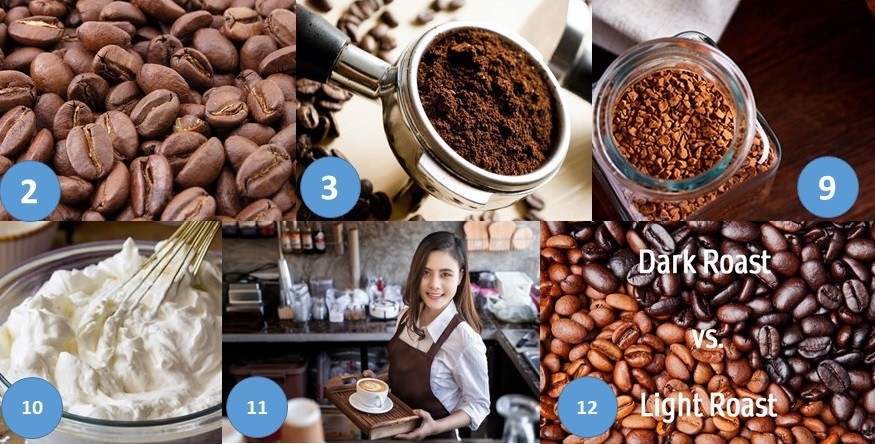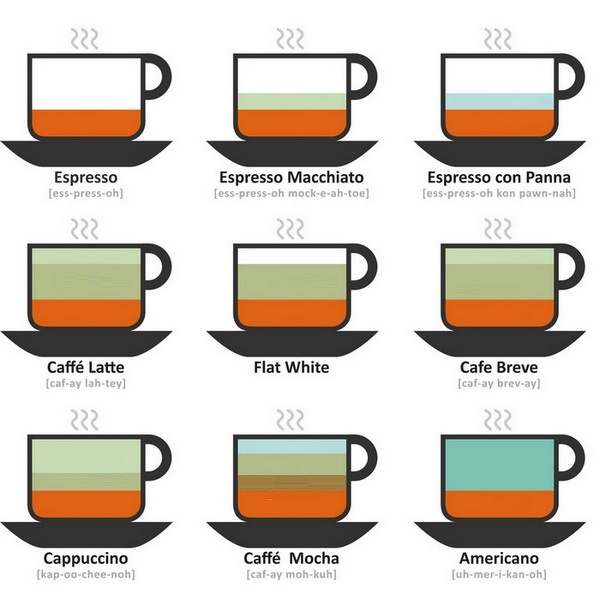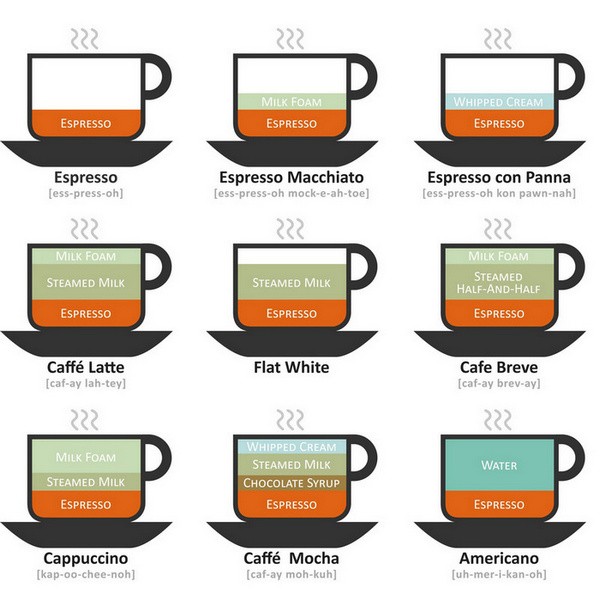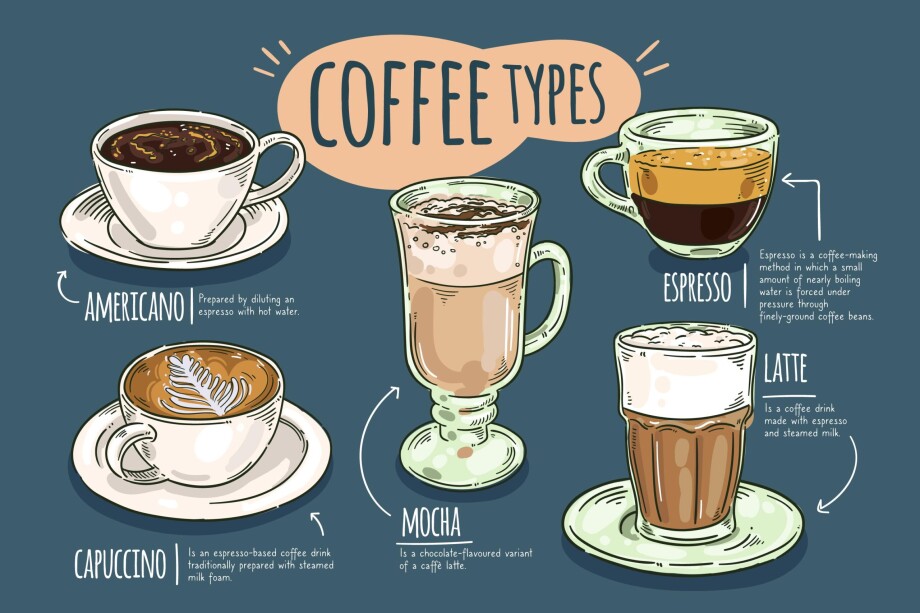Freshly brewed coffee is the best way to start off your day or to get you through a particularly long afternoon. Do you students love this drink? Why not use it to personalize your lessons? Below you can find some tasks for students who love coffee no matter its form — hot, iced, even decaf.
Task 1 — A tea or coffee person?
Scientists say that there is a big personality difference between tea and coffee drinkers. Start the lesson by identifying what type of drinker your students are.Ask to take a quiz. Here is one more quiz:
Task 2 — Facts about coffee
Then test the students’ knowledge of coffee using this quiz or this one. Alternatively, you can prepare interesting facts by yourself and ask students to read and mark them True or False.
You can prepare pictures that illustrate coffee vocabulary and refer to the words in bold.

- The word ‘coffee’ comes from the Arabic word ‘qahwah’ which means “dark” and was used for several dark drinks including tea, wine, and coffee.
- Coffee beans are only called ‘beans’ because of the resemblance — they’re actually berries.
- The word espresso comes from Italian and means “expressed” or “forced out”. Espresso is made by forcing very hot water under high pressure through finely ground, compacted coffee.
- The USA is home to the biggest coffee lovers.
- Coffee stays warm 20% longer when you add cream.
- “Kopi Luwak” is the most expensive coffee in the world. It comes from Indonesia and is made from beans partially digested from the Asian Palm Civet, a catlike creature. A cup of kopi luwak is sold for $80 in the United States.
- The Boston Tea Party helped popularize coffee in the UK.
- The grounds can beautify your skin if you use them as a DIY scrub.
- Instant coffee generally contains slightly less caffeine than regular coffee.
- Dalgona coffee was popularized on social media during the COVID-19 pandemic, when people refraining from going out started making videos of whipping the coffee at home, by hand. It is essentially whipped coffee that is consistent with the texture of whipped cream.
- The word barista comes from the Italian word for “bartender” and it is used to describe the men and women who prepare hot and cold coffee drinks and other beverages.
- As coffee roasts get darker, they lose the origin flavours of the beans and take on more flavour from the roasting process. The caffeine level decreases as the roast gets darker.
- Bitter taste perception determines the consumption of bitter-tasting beverages like coffee. People who carry the bitter taste receptor for caffeine are more likely to be heavy coffee drinkers, meaning they drink more than four cups of coffee a day.
Keys:
- True.
- True.
- True.
- False. Finland is home to the biggest coffee lovers. The average adult Finn goes through 27.5 pounds of coffee each year, according to the International Coffee Organization. Compare that to a measly 11 pounds per American.
- True.
- True.
- False. The Boston Tea Party helped popularize coffee in America. As a result, in the lead up to the Revolutionary War, it became a patriotic act to choose coffee over tea.
- True. Coffee grounds are physical exfoliators that can lift off dead skin cells, making skin feel smooth and look brighter. And caffeine is thought to improve blood circulation in skin, but there isn’t yet sufficient clinical data on its use in topical products.
- True.
- True.
- True.
- False. As coffee roasts get darker, they lose the origin flavours of the beans and take on more flavour from the roasting process. However, the caffeine level doesn’t change as the roast gets darker.
- True (read more).
Task 2 — Coffee vocabulary
It’s impossible to talk about the topic without knowing the necessary vocabulary.
Ask students to match the words and definitions. The pictures from task 1 will help them.
- A barista
- A coffee bean
- Coffee grounds
- To grind coffee beans
- Instant coffee
- To roast
- Whipped cream
a) The small pieces remaining after brewing coffee.
b) Coffee in the form of a powder that can be prepared very quickly by adding hot water.
c) To heat coffee beans so that they become drier and browner.
d) The person who prepares coffee at a coffee bar.
e) A cream that gets thicker when it is beaten with a special piece of equipment in order to make it thick and firm.
f) A seed of a tropical bush that is heated until it is brown and then crushed to make coffee.
g) To reduce to small bits or crush to a fine powder.
Keys:
- D
- F
- A
- G
- B
- C
- E
Task 3 — The basics about coffee
Play the video and ask students to find the answers to the questions:
1) What are the two coffee types?
2) What’s the difference between them?
3) How can you identify the coffee type?
4) What are the different roasts of coffee?
5) What are the two ways of making coffee mentioned in the video? What’s the difference in coffee?
Keys:
- Arabica and Robusta
- Arabica has a smooth taste, less caffeine and is more expensive. Robusta has a bitter taste, more caffeine and is cheaper.
- It’s written on the package. Alternatively, you can understand it from the price: coffee with a higher percentage of Arabica is more expensive.
- The types of coffee roasts include light, medium, medium-dark (not mentioned in the video), and dark.
- 1 way — place the filter in the cup, put coffee in the filter (1 tablespoon of coffee per 1 cup) and slowly pour the water.
2 way — with a French press.
The coffee made on a filter is light and has a smooth taste. The coffee made on a French press is thicker and has a richer taste.
Then ask follow-up questions:
1) What information was new for you?
2) What coffee do you prefer: with a smooth or bitter taste?
3) What do you pay attention to when buying coffee?
4) Do you ever drink coffee with any hints?
Task 4 — Types of coffee drinks
Ask students to label the ingredients of different drinks.

Keys:

Homework
Ask to read an article about making a perfect coffee at home and make notes.
We continue recruiting teachers for short 15-minute Speaking lessons, Talks, for students at Skyeng online school.
If English is like a native language for you or you permanently live in the country where you speak English, try yourself as a teacher of speaking lessons.This job is perfect for you if you:
– Speak without a strong accent, you can grade your speech to the student’s level (from Elementary to Advanced),
– Feel the student needs and feel the mood of the conversation,
– Can identify mistakes in speech and correct them.
– A teaching certificate is not required, although it is welcomed. It will be a huge plus if you have any international certificates (CELTA, Toefl, etc.). However, the main thing is that you love teaching.We are looking for a teacher who:
– available for teaching 2 or more hours a day, 5 days a week.
– available during prime time for classes – from 08:00 to 12:00 Moscow time (weekends – optional).
– has a tidy workplace with a neutral background.Work details are discussed after recording a short trial video.
We are looking forward to your videos. Register using the link here >>>






 Вероника Аветисян
Вероника Аветисян 
 Маргарита Аветисян
Маргарита Аветисян 


